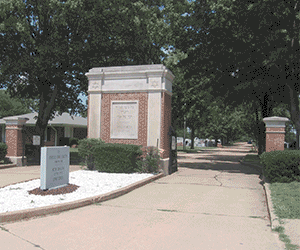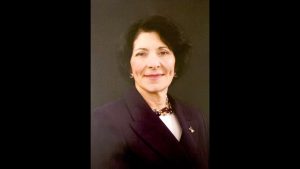Coming of age: NJT’s bar (or bat?) mitzvah year
Published September 10, 2009
Kathleen Sitzer, artistic director of the New Jewish Theatre, is looking forward to the upcoming 2009-2010 season, but she’s not sure whether to call it the “Bar Mitzvah” or “Bat Mitzvah” Season. It will be the 13th season either way, but according to Sitzer and Ed Coffield, one of her new artistic associates, a theater is usually referred to in the female gender — “the Grand Lady” is the usual term “Either way, we are looking forward to another terrific season,” said Sitzer during an interview last week, in which Coffield joined her. Coffield and Bobby Miller are two new official, but unpaid, artistic associates for the coming season.
“I just need some additional support,” said Sitzer. “With five plays per season now, I literally have no ‘down time,’ and so I’m very grateful that Ed and Bobby, two experienced and terrific theater people, will be providing some very important help.”
Here are some excerpts from the interview with Sitzer and Coffield.
Whether you call it a bar or bat mitzvah, that status usually means arriving at an adult level of maturity. Do you think NJT has attained that level as it prepares for its 13th season?
Sitzer: You are always seeking that goal, always trying to attain it. So, even though we have reached a certain level of maturity, it doesn’t mean that we are fully formed. We will continue to strive for theatrical and professional excellence at NJT.
Coffield: We have come through a tremendous growth period in the last eight years, and I think as we are about to look a brand new theater in the face, it will be another period of growth, which is great. These past six years, we have done one job, and I think we are on the precipice of our next growth period.
Why in particular, the past eight years?
Sitzer: Part of it is increased use of cast members who belong to Actors Equity. We started using Actors Equity people with Collected Stories, which was the first season that Ed directed, which was eight years ago. That season we had two, two-person shows, and each one had an Equity actor.
What is the significance of being a member of the Actors Equity?
Sitzer: It is the professional union of actors and stage managers in the United States. First of all, you have to have attained that status. You can’t just go out and buy your Equity card. You attain that status through a certain amount of work with Equity theater companies. Someone who has a card is assumed to be good enough to have worked with some of these upper-level professional theaters. It also frequently means that they are at such a level that they can make acting their regular gig. They are able to give all their energies to acting, which obviously is going to make for stronger performers, better skills.
Coffield: We don’t think of the Equity and non-Equity actors as a difference in talent, but Equity actors come to the table with a lot more work experience. They help keep everybody on their game, and bring up the level for everyone.
Sitzer: There are many non-Equity actors who are very talented, and we will continue to use both in our productions.
Last year, I noticed there was a huge crowd of actors waiting to audition for your shows. How do the present numbers compare to eight or 10 years ago in terms of actors auditioning for parts?
Sitzer: I’m going to go back maybe 10 years. I can remember auditioning when we did auditions for one show at a time. I can remember one show in particular, where we were looking down the hall to see if anyone was coming. More recently we have been auditioning for all of our shows.
Coffield: I can remember this past year having dozens of actors showing up for auditions for our shows. We don’t want there to be so many that they will get angry like a mob.
Sitzer: Frankly, our auditions have become so big, that we are considering another process. The auditions process is a two-step process. One audition is sort of a general audition, and we typically have actors prepare monologues for that, and those are one person at a time. Five minutes is all you get. From those auditions, you invite people to call-back auditions. In both cases for the general auditions, we had about 75 or 80 people.
Have you already cast the five shows for the upcoming season in its entirety?
Coffield: Yes, we did that in March, May and June. There is an odd phenomenon where some theaters in town start casting very early, as early as February, for the following fall. And it pushed the rest of us into a much earlier audition cycle that we are happy with. Last May I cast a show that I was going to direct 13 months later. We are trying to fight back against this pressure. It’s not the end of the world, but it’s just very strange to have such a long gap between audition and production.
Sitzer: An actor who has been cast in that 13 months might have a different opportunity they prefer, so you lose actors that way.
Last season, you used both the studio and large auditorium stages at Clayton High School while the Wohl Building is being renovated. How did that work out in general?
Sitzer: It’s been a tremendously good choice. The location is excellent in terms of our past audiences because most are familiar with Clayton. For those who are new to NJT, Clayton is a wonderful venue because it draws from Clayton, U. City and Maplewood, so it’s a great area for us to attract new audiences. It’s also a great venue in terms of free, well-lit parking and comfortable seating,
On the down side, because we’re working in a venue that’s not our own, we are subject to the school’s schedule, and obviously it comes first. This year, they have a resident theater company, so it’s first the school schedule, then the resident company and then ours. And it’s made scheduling difficult.
Will you have all five shows in the studio venue?
Sitzer: We open in the auditorium. That is strictly a matter of logistics, where they can put us. And we learned with the one show in the auditorium last year that it’s not a good venue. We have chosen Conversations with My Father (for that space), which has a larger cast. The set designer will know the issues with that space, and it will work much better in that space.
The next two will be in the black box, and then the fourth show, Romeo and Juliet, will be in the Missouri History Museum as part of its Performing Arts Series. This version of Romeo and Juliet is set during the British Mandate period in pre-Israel Palestine with Arabs and Jews in place of the warring families in Verona in Shakespeare’s original. This also gives a role to the British, and it becomes a historical piece rather than political, and that’s why the Missouri History Museum is perfect as the venue for this show. This will be a unique and original production, an adaptation by Robin Weatherall. It will appear during the time of Israel’s 61st anniversary.
What is the target date for completion of the new JCC space?
Sitzer: The latter half of February. Even so, there is no way we could do our February show there, and we are committed to the History Museum for Romeo and Juliet in April. There is a chance by our June show, Laughter on the 23rd Floor, we could be in our new space.
Where will the NJT space be in the refurbished Wohl Building?
Sitzer: In the stage end of the old Pasternak Autitorium, on the street level, which means it will be easier for our audience to get to than the old, lower level space.
How much has NJT grown over the 13 years in terms of subscribers?
Sitzer: Our first season we had a grand total of 60 season ticket holders. This past season we were up to 1,025. So, not only has NJT matured, but we have also dramatically grown.













